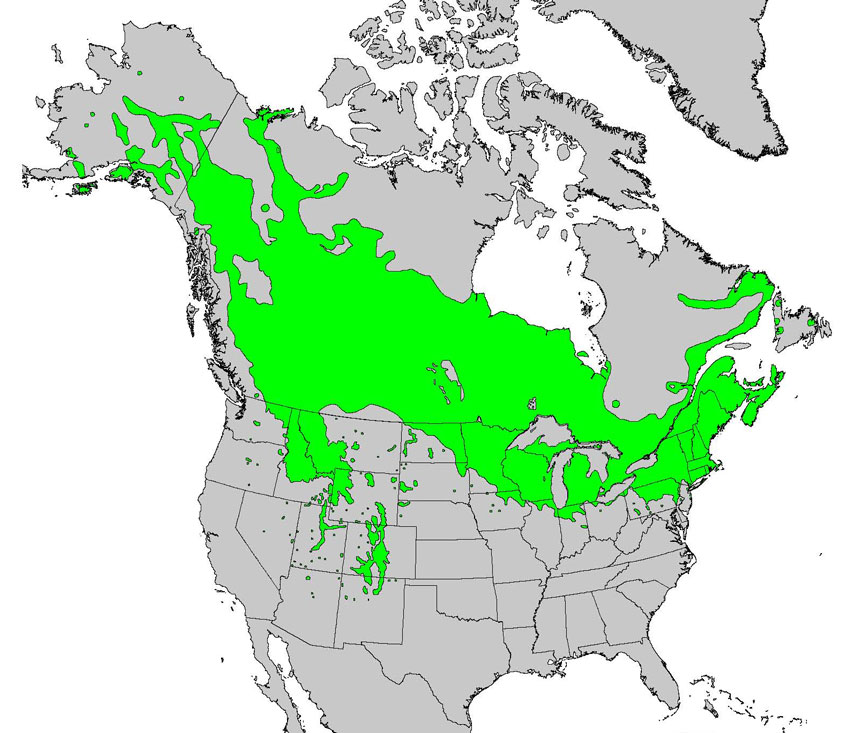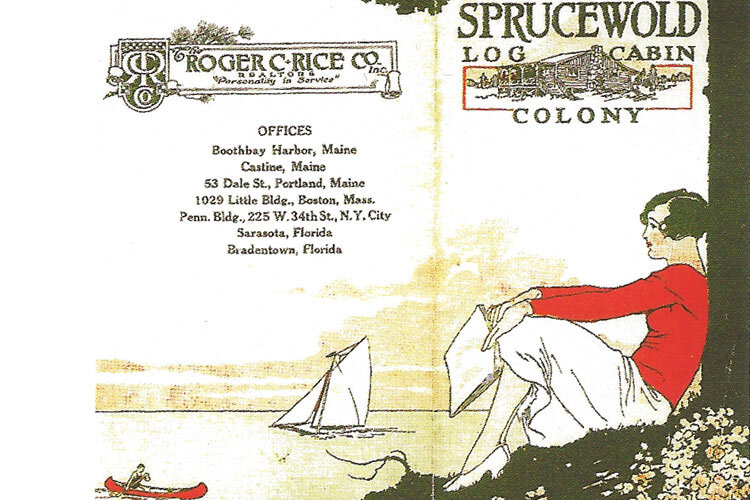Trees and the Rustic Furniture They Become, Part II
This article discusses six species of trees that were less commonly used during the original eras of rustic furniture design than the five species described in our previous journal article, Trees and the Rustic Furniture They Become, Part I. Photos and range maps of each tree species are presented, along with examples of antique rustic furniture made from each type of tree within the regions where it grows.
American Elm (Ulmus Americana)
American Elm trees, prized for their vase-like shape and broad canopy, were once common in forests and cultivated landscapes throughout eastern North America. While most mature elm trees (over 150 years old) have died in the past 50 years due to Dutch elm disease, saplings and young trees of this species can be found growing in forests throughout its range from the plains states eastward in the U.S., and into southern Canada and the Maritime Provinces.
Elm is a strong, dense wood that has been used over the centuries for products that needed to endure heavy use, such as wagon wheels and ship decks. Native Americans traditionally used elm wood for mortars. The Iroquoian tribes also used elm bark much like eastern tribes used birch bark to make utilitarian objects such as canoes and baskets. The photo below shows a set of rustic furniture with elm bark surfaces that was made by Ojibwa Indians in the Georgian Bay region of Canada. The thick, furrowed bark is distinctive, and makes a strong seat or table top.
Black Willow (Salix nigra)
Black Willow grows into the largest tree of the ninety species of willows occurring in North America, and it is the only commercially important willow. It is a short-lived, fast-growing tree found in wet and often sandy regions of river margins where it thrives at or slightly below water level. Although it has an extensive range in the southeastern portions of the U.S., it reaches its maximum size only in the lower Mississippi River Valley and Gulf Coastal Plain. Black willow trees yield a light, straight-grained wood.
This glider was made by Indiana Willow Products Company of Martinsville, Indiana, which was started in 1937 by former employees of Old Hickory Furniture Company. In the early years of its existence, the company made furniture frames out of willow in an attempt to distinguish itself from Old Hickory and Rustic Hickory Furniture companies, even though their furniture designs were nearly identical to their predecessors', as seen in the familiar form of this glider.
A second example is this stockade-style desk made of willow. This was most likely also made by Indiana Willow, as the design is based on a desk that appeared in an earlier Rustic Hickory Furniture Company catalog. While bark-on willow, like hickory, has an appealingly textured surface, hefting either this glider or desk reveals that willow wood is much less dense, making this furniture easier to move around.
Since willow was a difficult wood to acquire commercially, Indiana Willow Products Company soon began making furniture from hickory like their competitors. Early Indiana Willow pieces made of willow are rarely seen on the market - these two pieces in our inventory are among the few that we've owned.
Diamond Willow (as expressed on Salix bebbiana)
Diamond Willow is not actually a distinct tree species. Rather, it is a willow tree that has been attacked by a fungus which causes cankers in the trunk and branches. Although the fungus attacks at least six different species of willow, it is the Bebb Willow (Salix bebbiana - range map shown below) that is most often found with the characteristic diamond-shaped deformations. The range of Bebb willow is more northerly than that of black willow, which explains why the diamond willow wood formation is often considered to be a northern or boreal forest phenomenon.
Rustic furniture and accessories made with diamond willow tend to be smaller pieces rather than major tables or seating. The lamp, stand, and coat tree pictured below (circa 1920-40) are typical. Given the dramatic sculptural form of the wood, along with its handsome two-toned caramel and chocolate coloring, it is easy to see why it appealed to rustic craftsman as a raw material.
Mountain Laurel (Kalmia latifolia)
Mountain Laurel is a shrub with leathery, evergreen leaves. It is found in the understory in a variety of plant communities throughout its range, including in both softwood and hardwood forests. It grows in dry, rocky or sandy acidic soils on southern-facing slopes, ridges, and mountain hillsides where it can form thick, impenetrable thickets. It is common in the Appalachian Mountains and also grows in the plateaus and coastal plains of the southeastern U.S. While it was used for rustic furniture most often in the southern states, it does grow in southern New England where it is the state flower of Connecticut.
These shrubs are well adapted to living on ledges where their shallow roots grow horizontally along the surface of a ledge, and then at intervals shoot down into cracks to obtain water and nutrients. At those junctures between the horizontal and vertical roots, knobby burls develop. These are the "root burls" that rustic furniture makers traditionally harvested and used to great decorative effect.
Mt. Laurel root burl (jctwoodwork.com)
This chair (circa 1890) is a classic example of a vernacular form of rustic furniture being made at the turn of the 20th century in the Appalachian Mountains of West Virginia. It has peeled natural branch frames, halved branch slat seats, and elaborate laurel root burl lattice-work on the back and aprons. This chair was part of a rare set of four chairs, all with equally strong sculptural presence.
Striped Maple (Acer pensylvanicum)
As saplings, Striped Maples (also known as Moosewood) have dramatically large leaves relative to the size of their branches. It was always one of our favorite species to see in the understory as we trudged along portage paths in northeastern lake country carrying packs or canoes. It is a slow-growing tree that thrives in the cool, shady understory of northern mixed hardwood forests.
Given the limited range of striped maple, it is not surprising that rustic furniture made from it does not turn up in many places, or very often. We have only found antique furniture using this distinctive wood originating in Maine or the Adirondacks. The hefty table pictured below has a striped maple pedestal base, diagonal support braces and top edge trim, and was made in the Saranac Lake, NY region in the early 20th century.
Tamarack(Larix laricina)
Tamarack, also known as larch and hackmatack, is a deciduous conifer, meaning that its needles fall off in the autumn. In the northeastern U.S. it is found in bogs and lowlands, while in areas of the Midwest and Canada it grows as extensive forest stands. Its overall range is quite northerly, although it also occurs in higher elevations in more southerly states such as West Virginia and western Maryland.
Occasionally we find rustic furniture that uses natural elements in a way that we had never seen before. That is the case with a set of furniture encrusted with tamarack branch collars, which is the raised area where a branch meets the tree trunk. The rocking chair pictured below is from that set. It originated in the Maritime Provinces where it was made in the early 1900s. The shape and color of the applied tamarack pieces yield an overall impression of seashells, yet the chair is made entirely of wood. The creativity of rustic furniture makers in past eras never ceases to amaze.
Awareness
The makers of unique rustic furniture a century ago were naturalists and woodsmen who had a thorough knowledge of the habits and habitats of trees and shrubs in their local area. It takes time and a bit of disciplined study to develop that kind of awareness, just as it does to develop familiarity with the intricacies and varieties of rustic furniture. Our two articles on trees and the rustic furniture they become are presented to encourage readers to experience both some immersion in nature and in the aesthetics of early rustic furniture. Both pursuits are enriching, to whatever level they're taken.
(Tree photos: jeffpippen.com; missouribotanicalgarden.org, nhmountainhiking.com; uwgb.edu; perverdonk.com. Range maps: usgs.gov. Furniture photos: cherrygallery.com)








































